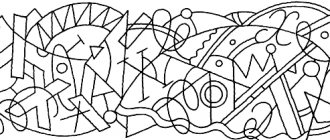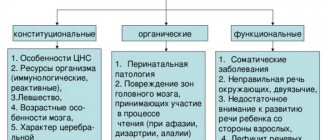Home — About speech therapy — Dyslexia specific reading disorders
Speaking of dyslexia. We mean conditions that are based on a persistent selective inability to master reading skills, despite a sufficient level of intellectual and speech development.
The core disorder in this case is a persistent inability to master syllable fusion and automated reading of whole words, which is often accompanied by a lack of understanding of what is read.
A child suffering from dyslexia, in addition to the above main disorder, has
- Phenomena of emotional-volitional immaturity;
- Has problems with the perception of written/printed information due to disruption of the processes of deployment, sequencing and switching. Doesn't recognize the words, can't understand what exactly he just read.
- Has difficulty developing writing skills, problems with spelling and spelling.
- Disorders of the central nervous system, manifested in behavioral disorders.
- Specific disorders of memory and attention.
general information
Speech therapy deals with issues of written speech disorders. It is customary to distinguish alexia - a complete inability to master reading, dyslexia - the student is able to partially master the process.
There are different classifications of dyslexia. R. Becker based it on the degree of manifestation. With literal learning, difficulties arise with mastering letters; with verbal learning, it is difficult to master words. He identified different types of reading disorders.
In speech therapy, the classification developed by Khvattsev has become widespread. He identified semantic, mnestic, phonemic, optical-spatial, and optical dyslexia.
Research was carried out in Europe. According to them, among children at the elementary level of education, 10% have various problems with written speech. Becker noted that in general schools, 3% of students are diagnosed with dyslexia; in correctional schools of the fifth type (for children with severe speech disorders), this figure rises to 22%.
You can only talk about problems with reading or writing at school age; preschoolers may have prerequisites for their occurrence.
Lalaeva also conducted similar studies. According to them, in special education the share of such children is 62% of all primary school students. In institutions for persons with mental retardation - 50%. The problem is more common in boys than girls.
Article:
In modern specialized literature, the following terms are mainly used to denote reading disorders: alexia - to denote a complete lack of reading;
dyslexia, developmental dyslexia, or developmental dyslexia to refer to a partial disorder of reading acquisition. “Dyslexia is a partial specific disorder of the reading process, caused by unformation (impairment) of higher mental functions and manifested in repeated, persistent errors” (A.N. Kornev, 1997, p. 7).
R.I. Lalaeva (2002, p. 20) agrees with this definition and emphasizes the fact that the features of dyslexic errors are their typicality, repetitive and persistent nature.
M.E. Khvattsev (1959) defines dyslexia as a partial disorder of the reading process, which makes it difficult to master this skill and leads to many errors during reading (omission of letters, syllables, substitutions, rearrangements, omission of prepositions, conjunctions, substitution of words, omission of lines).
The approach to the problem of the etiology of reading disorders has now changed significantly, become deeper and more complex. A.N. Kornev (1997) believes that the analysis of the etiology and pathogenesis of reading disorders in children should address three groups of issues: a) constitutional prerequisites that are significant for mastering reading; b) exogenous damaging effects on their possible consequences; c) living and learning conditions, as well as the basis of psychological skills necessary for mastering reading, taking into account the methods of teaching reading used.
Even D. Ginshelwood (1917) drew attention to the presence of repeated cases of dyslexia in the same families. According to A.N. Korneva, among children with dyslexia, in 60% of cases, heredity was burdened by a wide range of borderline mental disorders in close relatives, and only 25% - by reading disorders.
Thus, in children with dyslexia, hereditary predisposition plays an important etiological role.
Most authors studying reading disorders in children consider dyslexia as a disorder caused by the external influence of pathological factors. Such an impact causes a delay or disruption in the development of mental functions that carry out the normal reading process.
Most often, children with reading disorders have a history of two or three exogenous hazards. Disabilities of the ante-, peri- and early postnatal periods occur in children with dyslexia in 85% of cases. 69% of cases in the anamnesis of children with dyslexia include complications of the ante- and perinatal periods: toxicosis of pregnancy, threatened miscarriage, Rh conflict, somatic diseases, and 27% prematurity and twins.
Neuroinfections, head injuries or the so-called “chain of childhood infections” occur in 52% of dyslexia. In the etiology of dyslexia, a more important role belongs to relatively late-acting pathogenic factors (intra- and postnatal period). In 46% of cases, their ontogenesis is complicated by the influence of several (two to four) damaging factors. Most often, complications of the birth period are followed by diseases of the postnatal period, i.e. Each previous complication increases the risk of a subsequent one. For example, genetic abnormalities of the fetus often provoke complications during pregnancy. And this, in turn, provokes postnatal neuroinfections and other somatic diseases (A.N. Kornev, 1997).
The most well-known types of lesions in the pre-, peri- and postnatal periods are: a) hypoxic, b) toxic, c) infectious and d) mechanical. Let's look at them briefly.
a) the hypoxic type is associated with the following complications - improper implantation of the egg, anemia and heart disease in the mother, fetal heart defects, malformations of the fetus and placenta, premature partial placental abruption, abnormal development of the umbilical cord, prolonged labor, asphyxia during childbirth;
b) toxic - with drug intoxication, diabetes, maternal alcoholism and metabolic disorders, as a result of which, incompatibility of the blood of the mother and fetus;
c) the infectious type of lesion in the embryonic period (from the 4th week to the 4th month of pregnancy) is observed with rubella, measles, herpes, chicken pox, polio, influenza, in the fetal period - viral and bacterial neuroinfections;
d) mechanical type - with fetal expulsion manipulations, twinning, pelvic tumors, protracted labor, intracranial hemorrhages caused by premature birth, traumatic brain injury in the postnatal period (A.N. Kornev, 1997; R.I. Lalaeva, 2002).
R.I. Lalaeva (2002, p. 26) points out that the time of defeat is of great importance, i.e. stage of development with which the damaging effect coincided. The researcher writes that “the most significant negative role in the occurrence of dyslexia is played by pathological factors that act in later periods of fetal development and in the postnatal period..., because they influence the formation of late maturing structures of the cerebral cortex, in particular the tertiary zones that ensure the functioning of complex symbolic functions (speaking, reading, writing).”
Children with specific reading disorders have a pronounced uneven development of individual sensorimotor and intellectual functions. With dysontogenesis, learning difficulties arise not only due to the immaturity of certain functions, but also due to disharmony in their maturation as a systemic formation. This introduces disorganization into their interaction and coordination in the formation of the functional basis of reading.
The persistence of dyslexia gives reason to associate this with partial underdevelopment of a number of mental functions.
Thus, three types of dysontogenesis are involved in the pathogenesis of reading disorder: delayed development, developmental asynchrony and partial mental underdevelopment. In various clinical variants of dyslexia, these types of dysontogenies are presented to varying degrees. In familial, genetically determined disorders, dysontogenesis is closer to a delayed type of development. In encephalopathic variants of these conditions, manifestations of developmental asynchrony and partial underdevelopment dominate (R.E. Levina, 1940).
Classification of dyslexia. R. Becker (1967) notes the variety of types of reading disorders. He considers it possible to group them into the following types: congenital word blindness, dyslexia, bradylexia, legasthenia, congenital reading weakness. This classification is based on the degree of manifestation of reading impairment.
O.A. Tokareva (1969) classifies reading disorders depending on which of the analyzers is primarily impaired: auditory, visual, motor. And in this regard, he distinguishes acoustic, optical and motor forms of dyslexia. Taking into account the modern understanding of the systemic structure of higher cortical functions, when classifying dyslexia it is necessary to take into account not only analytical disorders, but also the nature of violations of higher technical functions, violations not only of the sensorimotor level, but also of the higher, symbolic, linguistic level.
M.E. Khvattsev (1959), based on impaired mechanisms, distinguishes phonemic, optical, optical-spatial, semantic and mnestic dyslexia. He believes that only phonemic and optical forms of dyslexia are observed in children. Other forms are observed in aphasia due to organic brain lesions. In the classification of M.E. Khvattsev does not take into account all operations of the reading process. The presented types of dyslexia in children do not cover all cases of reading disorders.
Taking into account the disrupted operations of the reading process R.I. Lalaeva (2002) identifies the following types of dyslexia: phonemic, semantic, agrammatic, mnestic, optical, tactile.
The symptoms of dyslexia are defined differently depending on the understanding of the essence of these disorders.
As R.I. points out. Lalaeva (2002), dyslexia manifests itself in a slowdown in the process of mastering reading, as well as in a slower pace and speed of reading (bradylexia). Children experience disturbances in eye movement during reading (chaotic, erratic, uneven, spasmodic). There are a large number of regressions, excessive duration of fixations, persistent and specific reading errors.
Error groups.
1. Replacement and mixing of sounds when reading: replacement and mixing of phonetically similar sounds (voiced and unvoiced, affricates and sounds included in their composition), as well as replacement of graphically similar letters (X - Ж, П - Н, 3 - В, etc. ).
2. Letter-by-letter reading - a violation of the merging of sounds into syllables and words. When reading letter by letter, the letters are named one by one, “stacked”, strung one on top of the other.
3. Distortions of the sound-syllable structure of a word, which manifest themselves in a variety of errors: a) omissions of consonants in the case of a confluence, b) omissions of consonants and vowels in the absence of a confluence, c) additions of sounds, d) rearrangements of sounds, e) omissions, rearrangements of syllables, etc. .
4. Reading comprehension impairments occur at the level of the individual word, as well as sentences and text. This group of reading disorders is identified in cases where there is no disorder in the technical side of the reading process.
5. Agrammatisms when reading. This group of errors manifests itself at the analytical-synthetic and synthetic stages of mastering reading skills. There are violations in case endings, in agreement between noun and adjective, changes in verb endings, etc.
The symptoms and course of dyslexia largely depend on the type of dyslexia, severity, and also on the stage of reading acquisition.
At the analytical stage of mastering reading (at the stage of mastering sound-letter notations and syllable-by-syllable reading), reading disorders most often manifest themselves in sound substitutions, impaired merging of sounds into syllables (letter-by-letter reading), distortion of the sound-syllable structure of a word, and impaired reading comprehension. At this stage, the most common is phonemic dyslexia, caused by underdevelopment of the function of the phonemic system (phonemic perception and phonemic analysis).
At the stage of transition to synthetic reading techniques, the symptoms of dyslexia are most often expressed in distortions of the structure of difficult words, word substitutions, agrammatisms, and impaired understanding of a read sentence or text.
At the stage of synthetic reading, children with disabilities experience word substitutions, agrammatisms, and impaired understanding of the text they read. Most often, agrammatic dyslexia is observed, caused by underdevelopment of the lexico-grammatical aspect of speech.
Reading disorders can negatively affect the development of a child’s personality. Failures in mastering reading can cause and consolidate such character traits as self-doubt, timidity, anxious suspiciousness or, conversely, embitterment, aggressiveness, and a tendency to negative reactions. In all these cases, affective reactions are a consequence of difficulties in reading.
A.N. Kornev (1997), L.G. Kobzareva, T.I. Kuzmina (2000), R.I. Lalaeva (2002) indicate that children with reading disabilities experience difficulties in orientation in all spatial directions, difficulties in determining right and left, up and down. There is inaccuracy in determining the shape and size. The lack of formation of spatial representations is manifested in drawing, in the difficulties of composing a whole from parts during construction, in the inability to reproduce a given shape. There is a delay in differentiating the right and left parts of the body, late lateralization or impaired lateralization (left-handedness, mixed dominance).
Thus, sufficient development of spatial representations is a necessary prerequisite for the recognition and assimilation of letters by a child.
In addition, many researchers note that children with dyslexia often have oral language impairments. The violations are of a varied nature: violations of sound pronunciation, poor vocabulary, inaccurate use of words. They formulate their speech incorrectly, avoid complex phrases, limit themselves to short sentences, and often have problems with coherent speech.
In the speech therapy literature, there are attempts to systematize the manifestations of reading disorders. So, for example, R.E. Levina (1940) identifies the following main types of manifestations of dyslexia: 1) insufficient mastery of letters; 2) insufficient merging of letters into syllables; 3) incorrect reading of a word or phrase. The author believes that in mild cases these disorders are detected only at the stage of mastering written speech. In difficult cases, oral speech appears to be impaired first of all, and reading impairments are detected later. According to R.E. Levina, the basis for reading and speaking disorders is the immaturity of the phonemic system.
L.F. Spirova (1965) points out that at the initial stages of mastering reading, with underdevelopment of the phonetic-phonemic aspect of speech in children, inaccuracy and instability of speech ideas and generalizations are observed. This makes it difficult to master the sound analysis of a word. Selective failure to assimilate letters is caused not by weakness in retaining graphic outlines, the assimilation of which turns out to be normal, but by the lack of formation of generalization of sounds. If a letter does not correlate with a generalized sound (phoneme), then its assimilation will be mechanical in nature.
Sounds that are accurately perceived and correctly pronounced by children are easily correlated with letters. If children poorly distinguish sounds by ear, pronounce them distortedly or replace them in pronunciation, then the generalized idea of a given sound is fuzzy, and the perception of letters becomes difficult. Failure to assimilate letters in this case is due to an insufficient level of development of phonetic perception.
The process of merging sounds into syllables is also extremely difficult for these children. To master continuous reading, a child must correlate a letter only with a certain sound, differentiating it from others. In addition, he must have an idea of its general sound. As G.A. writes Kashe (1971, p. 51), “To merge sounds into syllables is, first of all, to pronounce them as they sound in spoken language. If a child does not have clear ideas about the sound-letter composition of a word, the formation of generalized sound-syllable images is difficult.”
R. Becker (1967) notes that reading disorders may be associated with insufficient lexical and grammatical development of speech. Replacing words when reading can also be caused by difficulties in establishing syntactic connections in a sentence. In these cases, children lack focus on the morphological analysis of words, and the analysis itself is difficult. In the process of reading, a normal child begins to guess the meaning and grammatical form of subsequent words already when perceiving the previous word. The semantic guess in this case is based on his existing ideas about the laws of language, on the feeling of language.
If a child’s lexico-grammatical structure of speech is impaired, there is no reliance on precise linguistic generalizations, on clear ideas about the patterns of word change and their compatibility in a sentence, the semantic guess in this case is either absent or plays a negative role, since it leads to a large number of specific errors.
If the morphological structure of a word is not sufficiently understood by children, then during the reading process a correct semantic guess does not arise, and agrammatism occurs, associated with difficulties in perceiving subtle grammatical meanings determined by the morphological structure of the word. Limited vocabulary and underdeveloped grammatical generalizations cause difficulties in reading comprehension.
Thus, violations of sound pronunciation, phonemic perception (phoneme differentiation), phonemic analysis and synthesis, and immaturity of the lexico-grammatical structure of speech cause difficulties in reading.
To summarize, we can draw the following brief conclusions:
1. Dyslexia is a partial disorder of the process of mastering reading, manifested in numerous repeated errors of a persistent nature, due to the immaturity of the mental functions involved in the reading process.
2. Views, teachings, definitions and terminology have changed repeatedly over more than half a century of studying the problem, and yet a single point of view has not yet been found. No one doubts that there are children with selective reading disabilities. However, the essence of this phenomenon is understood differently. From modern research by scientists it is clear that three types of ontogenesis take part in the pathogenesis of reading disorders: delayed development, developmental asynchrony and partial mental underdevelopment. Dysontogyny may present to varying degrees depending on the clinical disorder.
3. The etiology of dyslexia involves both genetic and exogenous factors (pathology of pregnancy, childbirth, asphyxia, childhood infections, head injuries).
4. The classification of dyslexia is based on various criteria: the degree of severity of reading impairments (R. Becker), disturbances in the activity of analyzers involved in the act of reading (O.I. Tokareva), violations of certain mental functions (M.E. Khvattsev, R. O.E. Levin and others), accounting for the operations of the reading process (R.I. Lalaeva).
5. Reading disorders manifest themselves in a slowdown in the process of mastering reading, in a slower pace and speed of reading, and in a large number of persistent and specific errors. The symptoms and course of dyslexia largely depend on the type of dyslexia, severity, and also on the stage of reading acquisition.
6. Children with dyslexia experience difficulties in orientation in all spatial directions, difficulties in determining right and left, top and bottom, inaccuracy in determining shape and size. Impairments in oral speech are noted: disturbances in sound pronunciation, poor vocabulary, inaccurate use of words, incorrect speech formatting, and most often, coherent speech is impaired.
7. The later dyslexia is discovered, the more severe it reaches. References: 1. Becker R. Speech impairment as a factor causing difficulties in learning to read and spell. // V scientific session on defectology. - M., 1967. - P.44-49. 2. Kashe G.A. Prevention of reading and writing disorders in children with pronunciation deficiencies. Speech deficiencies in primary school students. / Ed. R.E. Levina. - M.: Education, 1971. - 191 p. 3. Kobzareva L.G., Kuzmina T.I. Early diagnosis of reading impairment. - M.: Gnom-Press, 2000. - 64 p. 4. Kornev A.N. Reading and writing disorders in children. - St. Petersburg: Publishing House "Mim", 1997. - 286 p. 5. Lalaeva R.I. Reading disorders and ways to correct them: Textbook. - St. Petersburg: Soyuz, 2002. - 224 p. 6. Levina R.E. Disadvantages of reading and writing in children. - M.: Uchpedgiz, 1940. - 72 p. 7. Spirova L.F. Disadvantages of reading and ways to overcome them. - M.: Publishing house of the Academy of Sciences of the RSFSR, 1965. - 55 p. 8. Tokareva O.A. Reading and writing disorders (dyslexia and dysgraphia). // Speech disorders in children and adolescents. / Under. ed. S.S. Lyapidevsky. - M.: Medicine, 1969. - P.190-212. 9. Khvattsev M.E. Speech therapy. - M.: Uchpedgiz, 1959. - 258 p.
Why does it occur
There is no consensus among experts about how written language disorders are formed. One group emphasizes hereditary predisposition. The following risk factors were identified in the twins:
- delayed speech development;
- left-handedness;
- neurological diseases.
Reinhold pointed out that this disorder is based on the immaturity of certain areas of the cerebral cortex. This manifests itself in delayed development of speech functions.
Experts agree that a combination of factors has an impact. Long-term somatic illnesses and brain damage (meningitis, encephalitis, trauma) can lead to problems. In adults, dyslexia occurs after a stroke or traumatic brain injury.
Social factors include bilingualism, speech defects in adults, and lack of contact. In an unfavorable environment, the formation of HMF does not occur.
The mechanism of dyslexia formation includes genetic, biological, and social factors. Most often, the cause of the disorder is minimal brain dysfunction. The children have intact intelligence and minor difficulties with HMF. Unlike oral speech disorders, dyslexia sometimes appears against the background of hearing loss, intellectual disability, and problems with the musculoskeletal system.
Dyslexia in schoolchildren with a normal level of intelligence has the following characteristic features:
- uneven or delayed physical development;
- unusual structure of intelligence;
- violation of the sequence of information perception, difficulty in perceiving a whole image.
Dyslexia can manifest itself in a variety of symptoms. Speech therapists diagnose students, identify risk groups, and examine in detail the processes of reading and writing.
Signs
Phonemic dyslexia is characterized by difficulty learning to read. Children cannot do this for 2-4 years. They have a hard time mastering letters and cannot combine them into syllables or words.
With this disorder, some children easily remember individual letters, but make mistakes during the reading process. They do not distinguish the letter as a grapheme.
Khvattsev believed that the basis of the problem was a violation of phonemic hearing. At preschool age, the child has not mastered the sound system; he does not distinguish sounds that are similar in sound ([S]-[C], [Sh]-[Zh]). An example of distorted perception: “dragged - dragged”, “egg - yaso”.
There is another form of phonemic dyslexia. With it, the student begins to read letter by letter and changes the structure of words. When consonants overlap, letters are skipped, a vowel is inserted between two consonants, syllables are rearranged and skipped.
Psychological symptoms are identified. Children have difficulties with spatial orientation; shapes and sizes are not accurately determined.
The correct development of spatial representations (right-left, top-bottom) is the basis for the acquisition of letters. To do this, they learn to navigate within the body (objects on the left or right), then move on to counting from the object (to the left of the cube lies...?). The third stage is the most difficult - orientation in three-dimensional space.
Only after this do they move on to spatial representations on paper. A preschooler should be able to determine the top of a page, the bottom, and find a line. Without these skills it is impossible to teach him to write.
Dyslexia correction
Dyslexia is treated with the help of special educational programs designed to help the child fill existing gaps in reading skills using special techniques taking into account the type of impairment. It is unacceptable to hope that dyslexia will go away “on its own” as the child grows up.
In any case, it should be remembered that dyslexia is not a death sentence. Children suffering from dyslexia can become artists in the future - like Leonardo da Vinci or Walt Disney, actors - like Dustin Hoffman or Quentin Tarantino, scientists - like Albert Einstein, and even writers - like Vladimir Mayakovsky or Hans Christian Andersen! All these great people also once suffered from dyslexia, but managed to solve their problem, and as a result achieved the highest results in their field.
Share:
Find out more about the Center's services and sign up for a consultation or lesson
You can call (812)
640-90-77
, or by filling out the form below.
Diagnostics
You can talk about problems with reading and writing by the end of second grade. The specialist sees alarming moments after the first year of school. A timely identified problem increases the chances of completely eliminating the defect.
Before starting correctional work, the speech therapist conducts a detailed examination. Parents of schoolchildren must consult with doctors who evaluate cognitive activity, the state of the nervous and visual systems.
The speech therapist studies medical documentation and collects anamnesis. It checks the condition of the organs of articulation, the level of active speech, general and fine motor skills. The level of speech hearing, phonemic analysis and synthesis is assessed. Grammar and vocabulary are checked.
The key point of diagnosis is to study the state of the writing and reading processes. To do this, the student is given a printed, handwritten text to copy, and then several sentences are dictated to him.
They study the ability to read individual letters, syllables, and words. Speed and reading comprehension are assessed.
At the end of the diagnosis, the speech therapist makes a conclusion about the degree and type of violation. If necessary, he recommends consultations with other specialists.
Diagnosis of dyslexia
- It is necessary to identify dyslexia in a child as early as possible. Moreover, as a rule, most parents do not suspect the presence of this problem until the child begins to learn letters in school or kindergarten. Therefore, it is recommended for preventive purposes to examine all children suffering from active and passive speech delay.
- The most important thing is to perform an EEG of the brain
- It is necessary to check the baby's visual acuity and hearing.
- An important component of diagnosis is a thorough medical and psychological examination, with the help of which it is possible to determine the presence of neurological disorders in order to certainly exclude other diseases “masquerading” as dyslexia and to choose the form of education that is preferable for the child in the future.
Areas of work
To overcome the problem, experts use different correction methods. The optimal number of lessons per week is 4 lessons. Work is being done to develop phonemic awareness. The student is taught to distinguish oppositional sounds by ear, and then reinforces this skill in writing and reading.
The difference in the pronunciation of sounds is clarified, and attention is focused on the sensations of articulation. If there are defects in oral speech, they are eliminated. If all sounds are intact, exaggerated articulation is practiced.
Work is underway to develop the skills of analysis and synthesis. Children should be able to identify a sound, a syllable, and draw up a sentence diagram. To practice the skill, tasks involving adding letters and syllables are offered.
A speech therapist helps develop vocabulary, teaches how to form new words, and use them in speech. The skill of oral and written coherent speech is trained.
Dyslexia in its pure form is rare; most often it is associated with a writing disorder. Therefore, work is carried out on both reading and writing.
Eliminating dyslexia requires 2-3 years of regular training. Parents need to constantly train the child, help him, and complete the tasks of the speech therapist. Sometimes you may need the help of a psychologist who will develop HMF.
Features of work
To implement each direction of correctional work, certain tasks are used. The speech therapist records which sounds the student confuses as he begins to implement the first stage of the process.
It consistently clarifies the pronunciation of the sound. For better assimilation of the image, a visual and tactile analyzer is used. The letter is made from beans, plasticine, sticks, and drawn on the sand.
To make it easier to identify the position of a sound, bird-shaped diagrams are used. A drawn bird, divided into three parts with vertical stripes: the head is the beginning of the word, the body is the middle, the tail is the end.
The second stage is the separation of two similar sounds by ear. To do this, they focus on auditory control skills.
To develop the sensitivity of the visual analyzer, “noisy pictures” are offered. Letters, objects, silhouettes are drawn on them and they are covered with a large number of strokes on top. The student needs to highlight and name everything that is depicted.
The student is offered a plot picture, based on which he comes up with sentences and counts the number of words. A more complex task - a diagram is given for which you need to select a suitable sentence.
At home, you can study using ready-made workbooks. There is a good manual by Oglobina. Mazanova has a good set.







